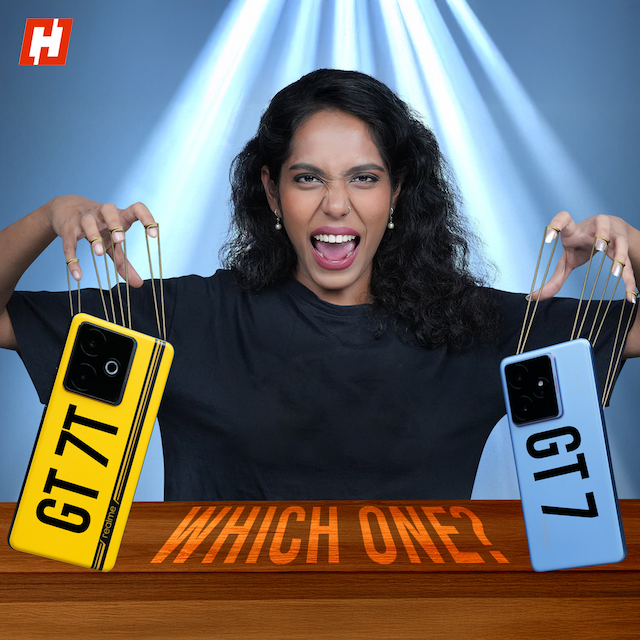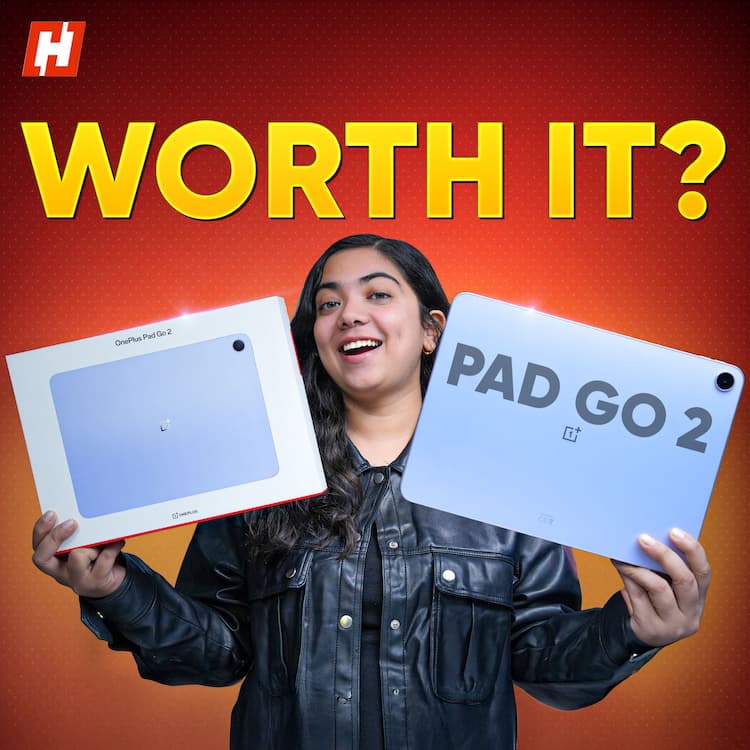Realme GT 7 vs GT 7T : Speed, style, and surprises unpacked

| Key specs | Realme GT 7 | Realme GT 7T |
| Processor | Mediatek Dimensity 9400e | Mediatek Dimensity 8400 Max |
| Display | 6.78-inch, 1.5K LTPO AMOLED, 1600 nits (HBM) | 6.8-inch, 1.5K LTPS AMOLED, 1800 nits (HBM) |
| Front Glass | Gorilla Glass 7i | Dragontrail STAR D+ |
| Cameras |
50MP Main+50MP 2X telephoto+8MP UW |
50MP Main+8MP UW |
| Front Camera | 32MP | 32MP |
| Battery & Charging | 7000mAh battery, 120W wired, 7.5W reverse, Bypass charging | 7000mAh battery, 120W wired, Bypass charging |
Realme’s GT 7 and GT 7T are back in action, kicking off at ₹39,999 and ₹34,999. The design stays classic GT, but the upgrades inside are anything but basic. These phones bring serious horsepower, bold AMOLED displays, and batteries built to go the distance.
I’ve pushed both to the limit—gaming, cameras, battery life, the works. And let’s just say, one of them punches way above its weight. If you're after max value, this face-off is worth your attention.
Realme GT 7 & GT 7T Review: Design
Let’s start with design, because this is where things were delightful, but also confusing at times. I checked out the GT 7 and GT 7T in both black and blue, and the blue definitely stole the show. It’s got just the right amount of character without being flashy. Clean lines, a sharp profile, and it even manages to look a little premium.
Now let’s shift gears to the GT 7T in Racing Yellow. This one takes a complete detour. It’s wrapped in vegan leather, with a thick racing stripe running down the side, and it doesn’t try to be subtle. It’s loud, sporty, and honestly, kind of a vibe. If you like your phone to turn heads, this is the colour you’ll want in your hand.
But wait till you see the GT 7 Dream Edition. Designed in collaboration with the Aston Martin Aramco F1 Team, it’s painted in a deep Aston Martin green, has a wing-inspired back, and even comes with a sleek silver-engraved badge. The box feels like a collector’s item. It’s the same phone inside as the standard GT 7, but this one is all about the flex. The Dream Edition is only available in a 16GB + 512GB variant and costs ₹49,999.
The regular models take inspiration from last year’s GT 7 Pro. The GT 7 has a plastic frame and a fibreglass back that feels surprisingly good in the hand. The GT 7T, thanks to that leather texture, feels a bit more luxurious, although it’s hard to say how it’ll hold up in the long run. There is a case in the box, but honestly, hiding that yellow back should be illegal.
Both phones get IP69 water and dust resistance, which is impressive at this price. The GT 7 pulls slightly ahead with Gorilla Glass 7i protection, while the 7T goes with Dragontrail STAR D+. In terms of handling, neither is slim or one-hand friendly. But funnily enough, the GT 7T in yellow felt lighter and more comfy, even though it's thicker on paper. The GT 7’s sharper edges made it a bit pokier to hold. That said, both feel solid, well-made, and ready for some rough use.
When it comes to in-hand feel, neither phone is particularly sleek or easy to handle with one hand. They’re both on the chunky side. Surprisingly though, the yellow GT 7T felt lighter and more comfortable to hold, even though it's technically thicker. The GT 7, on the other hand, has sharper edges that pressed into my palm a bit more during longer use. Still, both phones feel sturdy, well-built, and definitely don’t come off as cheap.
Realme GT 7 & GT 7T Review: Performance
I was really curious to see how much of a gap there is between the GT 7 and GT 7T in terms of performance. Last year, the GT 6 series pulled off a surprise when the cheaper GT 6T actually beat the regular GT 6 in some benchmarks. So naturally, I went into this with similar expectations. But this time, the results were very different.
The GT 7 runs on the Dimensity 9400e, while the GT 7T is powered by the Dimensity 8400 Max. And you can tell the difference almost instantly. In every benchmark I ran, including Antutu, Geekbench, and a few GPU-heavy tests, the GT 7 came out on top. It consistently delivered stronger scores and smoother performance across the board.
That gap was even more obvious when I fired up BGMI. The GT 7 ran the game at 120 frames per second with smooth graphics and Ultra frame rate. Meanwhile, the GT 7T topped out at 90 frames per second. So if your priority is gaming, especially at higher frame rates, the GT 7 is the clear winner.
Now, both phones did heat up a bit during heavy testing. The GT 7 hit around 45 degrees during stress tests, while the GT 7T stayed a few degrees cooler. But in real-world gaming sessions with GT Mode on, the GT 7 stayed around 38 degrees and the 7T at about 35. No overheating, no frame drops, and no weird slowdowns. Realme’s graphene-based cooling seems to be doing its job well.
For daily use, both phones felt super smooth. App launches were quick, multitasking was snappy, and animations looked slick. But when pushed hard, like in CPU throttling tests or during long multitasking sessions, the GT 7 held up better without any noticeable drops in performance.
Both devices come with 12GB of RAM and UFS 4.0 storage. I tested the 512GB versions, and they felt lightning fast. It’s still unclear if the 256GB variants use the same storage tech.
They’re also running Android 15 with Realme UI 6, which felt a lot like ColorOS. Clean, customisable, and way less cluttered than older versions. Realme has also promised four years of Android updates and six years of security patches, which is pretty impressive at this price.
Realme GT 7 & GT 7T Review: Displays
The display is where I kept flip-flopping. Both the GT 7 and GT 7T rock gorgeous 1.5K flat AMOLED panels with a 120Hz refresh rate. The 7T is slightly larger at 6.8 inches and has a slightly higher resolution, but honestly, unless you’re holding them side by side and really squinting, you won’t notice much of a difference.
Now here’s where things start to shift. The GT 7 uses an LTPO panel, which can dial the refresh rate all the way down to 1Hz when the screen’s idle. That’s great for battery life. The GT 7T, meanwhile, uses LTPS, so it’s not as flexible. It’s a small difference, but one that does help the GT 7 squeeze out a bit more efficiency.
The GT 7 also edges ahead in the visual tech department. It supports both HDR10+ and Dolby Vision, while the 7T sticks to just HDR10+. Peak brightness on the GT 7 is rated at 6000 nits, although that’s more of a short burst figure. In real-world use, it maxed out at 1600 nits in High Brightness Mode, compared to 1000 nits on the GT 7T. When I took them outside, the GT 7 did look noticeably brighter under the sun.
Both phones come with fast, reliable in-display fingerprint sensors that never missed a beat. The stereo speakers sound pretty much the same on both, with clear output and decent bass, and the haptics are snappy and well-tuned. All in all, both displays look fantastic, but if you want the more premium viewing experience, the GT 7 has a slight edge.
Realme GT 7 & GT 7T Review: Battery
Both the GT 7 and GT 7T come with a monster 7000mAh battery and 120W fast charging, and honestly, there’s nothing to complain about here. It’s the kind of spec that makes you double-check if it’s real. In my gaming test, a 30-minute BGMI session drained just 6 per cent on the GT 7 and 7 per cent on the GT 7T. After eight hours of mixed use, the GT 7 still had 50 per cent left, while the GT 7T was down to 41.
That slight edge likely comes from the GT 7’s more efficient chip. Both phones also offer bypass charging, which keeps the battery cool by pulling power straight from the charger during intense gaming.
As for charging speed, the GT 7 hit full in 42 minutes, and the GT 7T wasn’t far behind, clocking in at around 44.
Realme GT 7 & GT 7T Review: Cameras
Cameras are where things start to look different on paper. The GT 7 definitely appears to have the upper hand. It comes with a 50MP Sony IMX906 main sensor with OIS, a dedicated 50MP telephoto lens with 2x optical zoom, and an 8MP ultrawide camera. The GT 7T also packs a 50MP sensor with OIS, but it uses the more basic IMX896. There’s no telephoto lens here, and the ultrawide is the same one we saw on the GT 6.
But specs don’t always tell the full story. I tested both phones side by side and in good lighting, the results were surprisingly close. Both cameras delivered sharp detail and decent dynamic range. The 7T consistently went for brighter, slightly overexposed shots, while the GT 7 leaned into contrast and shadow depth. In low-light conditions, though, the GT 7 had the edge. It pulled out better detail in darker areas and overall clarity was a bit stronger.
When it came to video, both phones had their strengths. The GT 7 looked more stable during outdoor recording, but funnily enough, the GT 7T handled indoor jitters a little better. Both phones shoot 4K at 60fps from front and rear cameras, and the GT 7 also supports 8K at 30fps if you really want to push it.
The 8MP ultrawide lenses on both phones were just alright. They got the job done, but didn’t really impress. Dynamic range drops and edge softness were noticeable, especially in tricky lighting.
The one area I was most excited about was the GT 7’s telephoto lens. On paper, it sounds fancy—a 50MP sensor with 2x zoom. But it lacks OIS and has a shorter 47mm focal length, which makes it more of a portrait shooter than a real zoom lens. Portraits in daylight looked nice, but in dim lighting, most of them came out soft or slightly blurry. Ironically, the GT 7T performed better at 2x zoom in low light by digitally cropping into its main sensor.
Selfies from both phones were decent. They use the same 32MP front camera, but the GT 7 produced warmer tones, while the 7T leaned into brightness and slightly whitened skin tones.
Overall, the GT 7 offers more camera versatility. But for everyday snaps, the GT 7T holds its own and even edges ahead in some lighting conditions.
Realme GT 7 & GT 7T Review: Verdict
Bottomline? The Realme GT 7 starts at ₹39,999, and the GT 7T at ₹34,999. The GT 7 is the better performer overall — it’s faster, more efficient, and handles heat like a champ. The camera is decent, but it’s the clear pick for gamers. Still, the GT 7T isn’t far behind. It’s more affordable, runs well, and doesn’t feel like a downgrade. If you can wait, keep an eye out for a ₹3,000 to ₹4,000 drop on the GT 7. At that price, it’s easily one of the best performance-first phones out there.
Trending in Tech

OnePlus Pad Go 2 first impressions: Bigger screen, better power, mature design

Realme P4x Performance test — Can it handle everything?

Is the OnePlus 15R the mid-range phone to beat in 2026?

